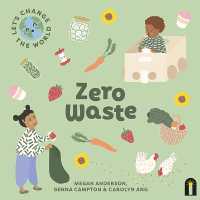- ホーム
- > 洋書
- > 英文書
- > Business / Economics
Full Description
Plant Factory: An Indoor Vertical Farming System for Efficient Quality Food Production, Second Edition presents a comprehensive look at the implementation of plant factory (PF) practices to yield food crops for both improved food security and environmental sustainability. Edited and authored by leading experts in PF and controlled environment agriculture (CEA), the book is divided into five sections, including an Overview and the Concept of Closed Plant Production Systems (CPPS), the Basics of Physics and Physiology - Environments and Their Effects, System Design, Construction, Cultivation and Management and Plant Factories in Operation.
In addition to new coverage on the rapid advancement of LED technology and its application in indoor vertical farming, other revisions to the new edition include updated information on the status of business R&D and selected commercial PFALs (plant factory with artificial lighting). Additional updates include those focused on micro and mini-PFALs for improving the quality of life in urban areas, the physics and physiology of light, the impact of PFAL on the medicinal components of plants, and the system design, construction, cultivation and management issues related to transplant production within closed systems, photoautotrophic micro-propagation and education, training and intensive business forums on PFs.
Contents
Part 1: Overview and concept of closed plant production system (CPPS)
1. Introduction
2. Role of the plant factory with artificial lighting (PFAL) in urban areas
3. PFAL business and R&D in Asia and North America: Status and perspectives
4. Vertical farming in Europe: Present status and outlook
5. Plant factory as a resource-efficient closed plant production system
6. Micro- and mini-PFALs for improving the quality of life in urban areas
7. Rooftop plant production systems in urban areas
Part 2: Basics of physics and physiology - Environments and their effects
8. Light sources
9. Plant responses to light
10. LED advancements for plant-factory artificial lighting
11. Physical environmental factors and their properties
12. Photosynthesis and respiration
13. Growth, development, transpiration, and translocation as affected by abiotic environmental factors
14. Nutrition and nutrient uptake in soilless culture systems
15. Tipburn
16. Functional components in leafy vegetables
17. Medicinal components
18. Production of pharmaceuticals in a specially designed plant factory
Part 3: System design, construction, cultivation and management
19. Plant production process, floor plan, and layout of PFAL
20. Hydroponic systems
21. Seeding, seedling production and transplanting
22. Transplant production in closed systems
23. Photoautotrophic micropropagation
24. Biological factor management
25. Design and management of PFALs
26. Automated technology in plant factories with artificial lighting
27. Life cycle assessment
28. Education, training, and business workshops and forums on plant factories
Part 4: PFALs in operation and its perspectives
29. Selected PFALs in the United States, the Netherlands, and China
30. Selected PFALs in Japan
31. Representative plant factories in Taiwan
32. Challenges for the next-generation PFALs
33. Conclusions: Resource-saving and resource-consuming characteristics of PFALs





